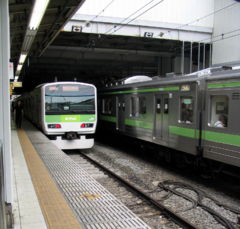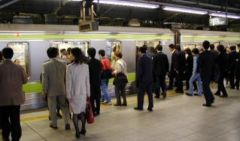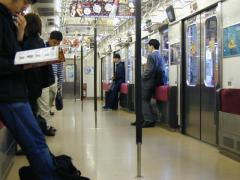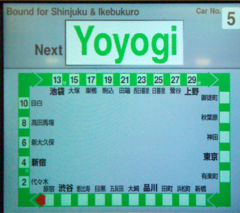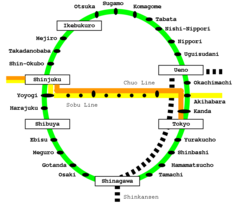Yamanote Line
The Yamanote Line (山手線 Yamanote-sen?) is one of Tokyo's busiest and most important commuter lines. Running as a circle, it connects most of Tokyo's major stations and urban centres including the Ginza area, Shibuya, Shinjuku and Ikebukuro with all but six of its 29 stations connecting with other railway or underground (subway) lines. It is operated by JR East.
Contents
Service
Trains run from about 4:30 am to about 1:20 am at intervals of 2.5 minutes at peak time. A complete loop takes 61 to 65 minutes. All trains stop at each station. Trains are put into and taken out of service at Ōsaki (which for timetabling purposes is the line's start and terminus) and sometimes Ikebukuro.
Trains which run clockwise are known as "soto-mawari" (外回り, outer circle) and counter-clockwise as "uchi-mawari" (内回り, inner circle).
The Yamanote Line is the only major line in Tokyo which does not have any through-running services to other lines.
The line also acts as a fare zone destination for JR tickets from locations outside Tokyo, permitting travel to any JR station on or within the loop.
The line colour used for all of the rolling stock, station signs and diagrams is Yellow Green #6 ■ (Munsell code 7.5GY 6.5/7.8).
History
The Yamanote Line originated in 1885 with the construction of the Shinagawa line between Shinagawa and Akabane, bypassing the then built up areas and providing the first north-south rail link through Tokyo. The top part of the loop between Ikebukuro and Tabata was completed in 1903 (known as the Toshima line, 豊島線) and in 1909 following electrification both lines were merged to become the Yamanote Line.
The complete loop was only completed in 1925 with the opening of the section of track between Kanda and Ueno, providing a north-south link via Tokyo station through the city's centre. The contemporary Yamanote Line came into being in 1956 when it was separated from the Keihin-Tōhoku Line and was given its own set of tracks along the eastern side of the loop between Shinagawa and Tabata.
As of 2005, the Yamanote Line carries on average 3.55 million passengers a day, or 1.3 billion a year. [1]
Name
"Yamanote" literally means "hand of the mountain" and in many Japanese cities is used to refer to inland, hillier districts (as opposed to areas close to the sea). In Tokyo "Yamanote" - as opposed to the lower lying "Shitamachi" (下町) - lies along the western side of the Yamanote Line loop.
Yamanote-sen is always written without the kana "no" (の or ノ). In the past it was sometimes transliterated as "Yamate" on train signboards. Although "Yamanote-sen" has always been the official term, "Yamate-sen" was very popular among passengers until 1971, when the then-JNR (Japan National Railways) changed all transliterations to "Yamanote" to reduce confusion. The effort to reduce confusion, however, began with the opening of the Agatsuma Line (吾妻線). To avoid the name "Agatsuma" being read as "Azuma", the usual reading ("ga" is another kana functioning in the same way as the "no" in "Yamanote"), it was decided that the readings of all JNR train lines would be specified. Another reason to name "Yamanote" with a "no" is the existence of "Yamate" station on the Negishi line in Yokohama, very close to the Yamanote line. However, some of the older generation still refer to the line as the Yamate line.
Note that in other areas of Japan, 山手 may be pronounced "yamate", for example the Seishin-Yamate Line in Kōbe, and of course Yamate-dōri (Yamate Street) which runs parallel to the west side of the Yamanote train line, and the Yamate area of Yokohama.
Trains
Services are provided by E231-500 series 11-car EMUs introduced from 2003 onwards. These replaced the previous 205 series trains, which were introduced in 1985 and phased out in April 2005. Earlier services consisted of 103 series trains, which were eventually phased out in 1988.
The E231 series trains include two 6-door cars (Japanese "roku-tobira-sha") in which the bench seats are folded up to provide standing room only during the morning rush hour (until 10 a.m.). All the other cars have four sets of doors on each side.
The E231 series supports a new type of traffic control system, called digital ATC (Automatic Train Control), which will help reduce one round trip to a very short 58 minutes. The series also has a more modern design and has two 15" LCD monitors above each door, one of which is used for displaying commercials, news and weather; and another which is used for displaying information on the next stop (in both Japanese and English) along with notification of delays on the Yamanote and other lines.
Stations
Only two of the Yamanote Line's 29 stations do not connect with other railway or subway lines.
Listed clockwise:
Since the distance between Shinagawa and Tamachi stations is 2.2km, making it the longest stretch of track on the Yamanote line, there are plans for a new station between those two stations with completion in or around 2010.
Ridership
An estimated 3.5 million passengers ride every day on Tokyo's Yamanote Line, with its 29 stations. For comparison, the New York City Subway carries 4.8 million passengers per day on 26 lines serving 468 stations.[1]
Trivia
- The City Hunter movie Goodbye My Sweetheart references the opening of the new "Yamate Line", which is the nickname of the Yamanote Line. However, the events in this movie depict the opening as in 1997 whereas the complete loop was completed in 1925.
References
External links
| Wikimedia Commons has media related to: Yamanote Line |
Mass transit in Tokyo | |
|---|---|
| Metro lines (Subway) | Chiyoda · Fukutoshin · Ginza · Hanzōmon · Hibiya · Marunouchi · Namboku · Tōzai · Yūrakuchō |
| Toei lines | Subway: Asakusa · Mita · Ōedo · Shinjuku Streetcar: Arakawa |
| JR lines | Yamanote · Chūō · Chūō-Sōbu · Jōban · Keihin-Tōhoku · Keiyō · Saikyō · Shōnan-Shinjuku · Sōbu · Tōkaidō · Yokosuka |
| Other networks | Keikyū · Keiō · Keisei · Nippori-Toneri · Odakyū · Seibu · Tōbu · Tokyo Monorail · Tōkyū · TWR · TX · Yurikamome |
| Around Tokyo | Chiba Monorail · Enoden · Hokusō · Saitama Rapid · Saitama New Urban · Shin-Keisei · Shōnan Monorail · Sōtetsu · Tama Monorail · Tōyō Rapid · Yokohama MM · Yokohama Subway |
| Terminals | Asakusa · Ikebukuro · Kita-Senju · Oshiage · Shibuya · Shinagawa · Shinjuku · Tōkyō · Ueno |
| Miscellaneous | PASMO · Passnet · Suica · Transportation in Greater Tokyo |
